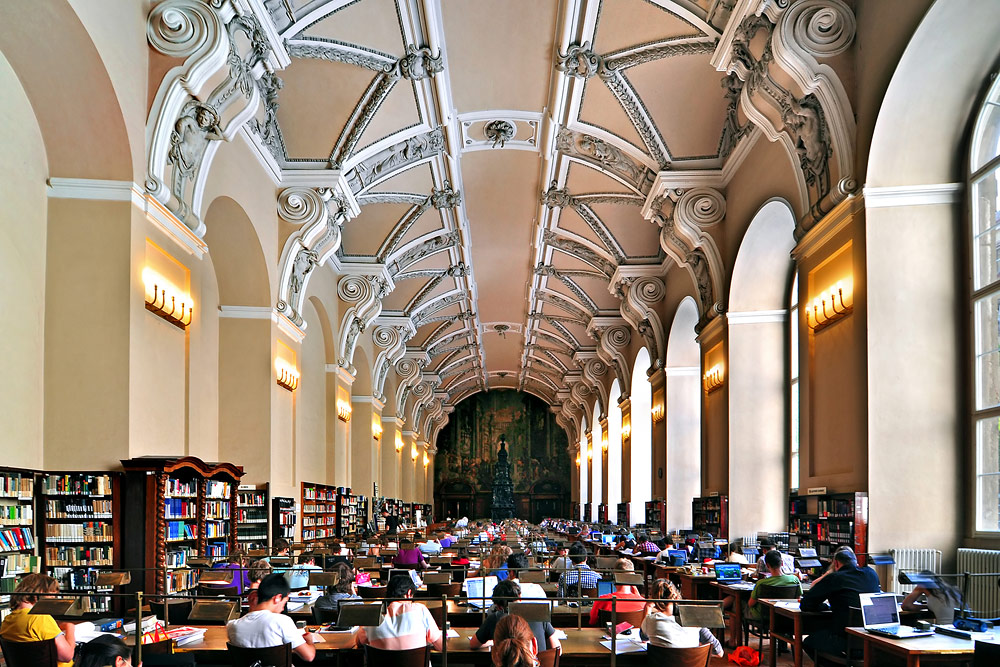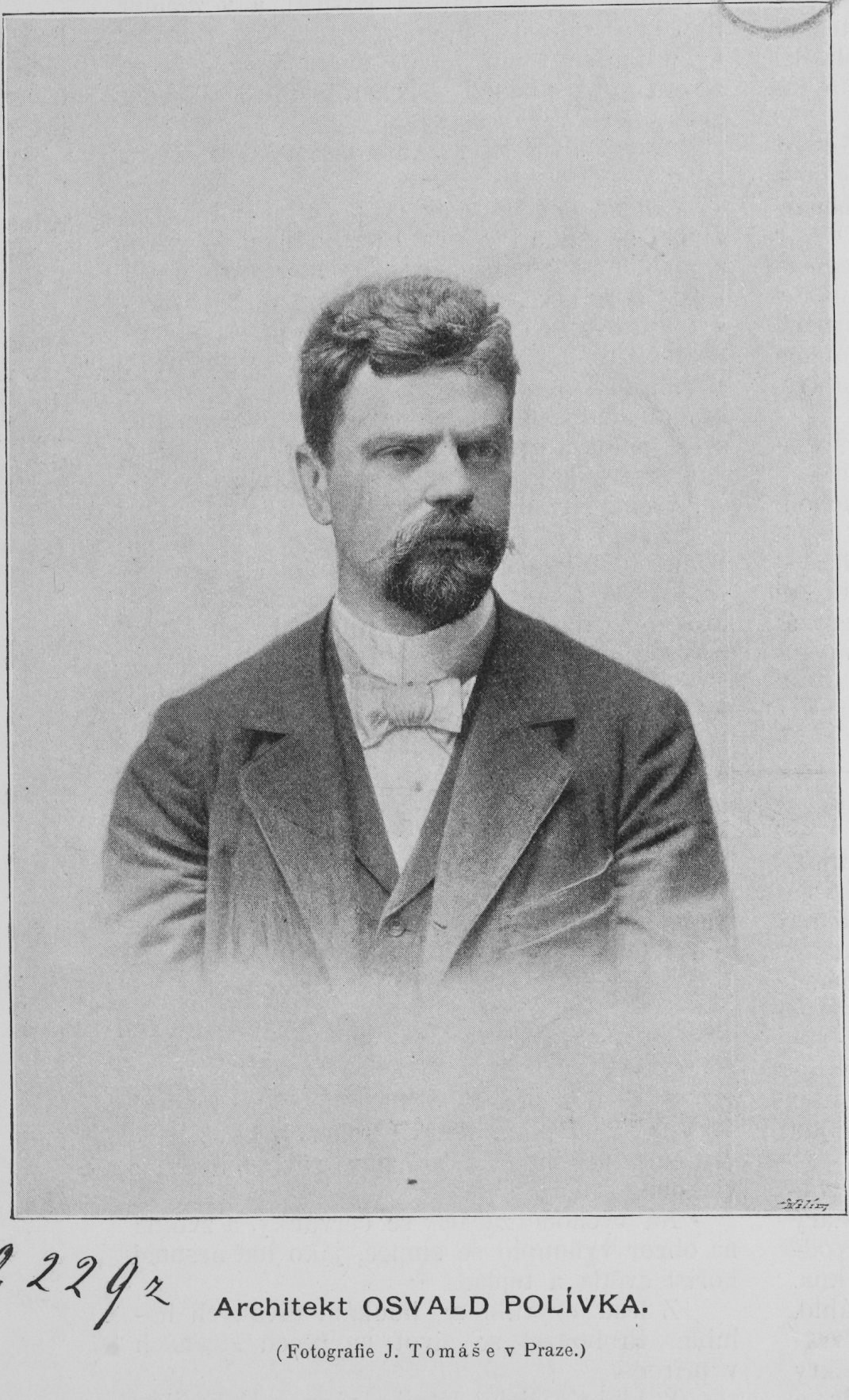|
Celda Klouńćek
Celda Klouńćek (born Celest√Ĺn Klouńćek; 6 December 1855, Senomaty ‚Äď 14 October 1935, Prague) was a Czech sculptor, designer, teacher, and paleontologist. Life and work He began his studies at the Academy of Arts, Architecture and Design in Prague, then transferred to the School of Applied Arts in Vienna. There, he worked in the studios of from 1878 to 1881. In addition to his studio work, he taught decorative sculpting at the Kunstgewerbeschule in Frankfurt. From 1888 to 1916, he was a professor at his alma mater in Prague; overseeing a studio for decorative drawing and modeling. He was also involved in the ceramics studio, and worked together with Professor Emanuel Nov√°k (1866‚Äď1918) in the Academy's artistic metal program. Since he was a young boy, he had collected minerals and fossils. Through his own studies, and collaborations with the paleontologists at the National Museum, he developed into a knowledgeable researcher; publishing his own discoveries in the professio ... [...More Info...] [...Related Items...] OR: [Wikipedia] [Google] [Baidu] |
Celda Klouńćek (1855-1935)
Celda Klouńćek (born Celest√Ĺn Klouńćek; 6 December 1855, Senomaty ‚Äď 14 October 1935, Prague) was a Czech sculptor, designer, teacher, and paleontologist. Life and work He began his studies at the Academy of Arts, Architecture and Design in Prague, then transferred to the School of Applied Arts in Vienna. There, he worked in the studios of from 1878 to 1881. In addition to his studio work, he taught decorative sculpting at the Kunstgewerbeschule in Frankfurt. From 1888 to 1916, he was a professor at his alma mater in Prague; overseeing a studio for decorative drawing and modeling. He was also involved in the ceramics studio, and worked together with Professor Emanuel Nov√°k (1866‚Äď1918) in the Academy's artistic metal program. Since he was a young boy, he had collected minerals and fossils. Through his own studies, and collaborations with the paleontologists at the National Museum, he developed into a knowledgeable researcher; publishing his own discoveries in the professio ... [...More Info...] [...Related Items...] OR: [Wikipedia] [Google] [Baidu] |
Arts And Crafts
A handicraft, sometimes more precisely expressed as artisanal handicraft or handmade, is any of a wide variety of types of work where useful and decorative objects are made completely by one’s hand or by using only simple, non-automated related tools like scissors, carving implements, or hooks. It is a traditional main sector of craft making and applies to a wide range of creative and design activities that are related to making things with one's hands and skill, including work with textiles, moldable and rigid materials, paper, plant fibers,clay etc. One of the oldest handicraft is Dhokra; this is a sort of metal casting that has been used in India for over 4,000 years and is still used. In Iranian Baluchistan, women still make red ware hand-made pottery with dotted ornaments, much similar to the 5000-year-old pottery tradition of Kalpurgan, an archaeological site near the village. Usually, the term is applied to traditional techniques of creating items (whether for per ... [...More Info...] [...Related Items...] OR: [Wikipedia] [Google] [Baidu] |
National Library Of The Czech Republic
The National Library of the Czech Republic ( cs, N√°rodn√≠ knihovna ńĆesk√© republiky) is the central library of the Czech Republic. It is directed by the Ministry of Culture. The library's main building is located in the historical Clementinum building in the centre of Prague, where approximately half of its books are kept. The other half of the collection is stored in the district of HostivaŇô. The National Library is the biggest library in the Czech Republic, housing around 6 million documents. The library currently has around 20,000 registered readers. Although comprising mostly Czech texts, the library also stores older material from Turkey, Iran and India. The library also houses books for Charles University in Prague. History In the 13th century, the ''Studium generale'' school was founded in the Dominican monastery in Prague's Old Town. This school, including its library, merged with the university in the 14th century. In 1556, monks of the Jesuit Order erected a boardi ... [...More Info...] [...Related Items...] OR: [Wikipedia] [Google] [Baidu] |
Jaroslav Perner
Jaroslav Perner (March 28, 1869 in T√Ĺnec nad Labem ‚Äď June 9, 1947 in Prague) was a Czech paleontologist. In 1927 Perner became professor of paleontology at the Charles University in Prague. He continued in work started by Joachim Barrande (the ''Syst√©me silurien du center de la Boh√©me''). He was also custodian of the Czech National Museum The National Museum (NM) (Czech: ''N√°rodn√≠ muzeum'') is a Czech museum institution intended to systematically establish, prepare, and publicly exhibit natural scientific and historical collections. It was founded in 1818 by KaŇ°par Maria ҆tern ... in Prague. External links Very short biography (in Czech) 1869 births 1947 deaths Czech paleontologists {{CzechRepublic-scientist-stub ... [...More Info...] [...Related Items...] OR: [Wikipedia] [Google] [Baidu] |
Hofburg
The Hofburg is the former principal imperial palace of the Habsburg dynasty. Located in the centre of Vienna, it was built in the 13th century and expanded several times afterwards. It also served as the imperial winter residence, as Schönbrunn Palace was the summer residence. Since 1946, it is the official residence and workplace of the president of Austria. Since 1279, the Hofburg area has been the documented seat of government.Aeiou-Hofburg-English , "Hofburg, Wien" (history), ''Encyclopedia of Austria'', Aeiou Project, 2006. The Hofburg has been expanded over the centuries to include various residences (with the ''Amalienburg'' and the ), the imperial chapel (''Hofkapelle'' or ''Burgkape ... [...More Info...] [...Related Items...] OR: [Wikipedia] [Google] [Baidu] |
Apostolic Nunciature To The Czech Republic
The Apostolic Nunciature to the Czech Republic ( cs, ApoŇ°tolsk√° nunciatura v ńĆesk√© republice) the diplomatic mission of the Holy See to the Czech Republic. It is located in Prague. The current Apostolic Nuncio is Archbishop Jude Thaddeus Okolo, who was named to the position by Pope Francis on 1 May 2022. The nunciature is an ecclesiastical office of the Catholic Church in the Czech Republic, with the rank of an embassy. The nuncio serves both as the ambassador of the Holy See to the President of the Czech Republic, and as delegate and point-of-contact between the Catholic hierarchy in the Czech Republic and the pope. Nuncios Archbishop Giovanni Coppa was named Apostolic Nuncio to Czechoslovakia on 30 June 1990. With the division on that country into Slovakia and the Czech Republic on 1 January 1993, Coppa became nuncio to each of them, based in Prague. * Giovanni Coppa (1 January 1993 ‚Äď 19 May 2001) * Erwin Josef Ender (19 May 2001 ‚Äď 25 November 2003) * Diego Causero (10 ... [...More Info...] [...Related Items...] OR: [Wikipedia] [Google] [Baidu] |
Prague Credit Bank
Prague ( ; cs, Praha ; german: Prag, ; la, Praga) is the capital and largest city in the Czech Republic, and the historical capital of Bohemia. On the Vltava river, Prague is home to about 1.3 million people. The city has a temperate oceanic climate, with relatively warm summers and chilly winters. Prague is a political, cultural, and economic hub of central Europe, with a rich history and Romanesque, Gothic, Renaissance and Baroque architectures. It was the capital of the Kingdom of Bohemia and residence of several Holy Roman Emperors, most notably Charles IV (r. 1346‚Äď1378). It was an important city to the Habsburg monarchy and Austro-Hungarian Empire. The city played major roles in the Bohemian and the Protestant Reformations, the Thirty Years' War and in 20th-century history as the capital of Czechoslovakia between the World Wars and the post-war Communist era. Prague is home to a number of well-known cultural attractions, many of which survived the violen ... [...More Info...] [...Related Items...] OR: [Wikipedia] [Google] [Baidu] |
Antonín Wiehl
Anton√≠n Wiehl (26 April 1846, Plasy ‚Äď 4 November 1910, Prague) was a Czech architect, museum official, and patron of the arts. He helped create the first system of historic preservation in Bohemia. Biography His father was an Austrian forestry official, assigned to the estates of Klemens von Metternich. He attended the Realschule in PlzeŇą, then received his secondary education in Prague. From 1863 to 1868, he was enrolled at the Polytechnic. He began his civil engineering course with Professor , who retired in 1864, then continued with Josef Z√≠tek. From 1869 to 1870, he was in SlatiŇąany, working for a construction company owned by the architect, , who did restorations and was a regional conservator for the Vienna Central Commission that oversaw the preservation of monuments. During Wiehl's time with the company, he gained invaluable experience doing restorative work on a number of churches. Following his employment there, he returned to the Polytechnic and was an assistan ... [...More Info...] [...Related Items...] OR: [Wikipedia] [Google] [Baidu] |
Osvald Polívka
Osvald Pol√≠vka (24 May 1859 in Enns ‚Äď 30 April 1931 in Prague) was an Austrian-born Czech architect associated with the Art Nouveau period in Prague. Pol√≠vka designed many of Prague's significant landmarks of the era, plus other work in Brno and elsewhere. After graduating from Czech Polytechnic in Prague, his first important commission was a collaboration with Anton√≠n Wiehl, the 1894 Prague City Savings Bank. Pol√≠vka's style evolved through his active years but he remained devoted to the collaborating with artists for aesthetic effect. For the ornate landmark Municipal House he coordinated the work of many significant Czech muralists and sculptors of the time, including his friend Alfons Mucha. He is buried at OlŇ°any Cemetery in Prague. Major architectural projects * Prague City Savings Bank, Old Town Square, together with Anton√≠n Wiehl, 1894, with distinctive architectural sculptural groups by Bohuslav Schnirch * Zemsk√° Banka head office, Na pŇô√≠kopńõ, 1895-1896 ... [...More Info...] [...Related Items...] OR: [Wikipedia] [Google] [Baidu] |
Zemsk√° Banka
Zemsk√° Banka (german: Landesbank) was a significant state-sponsored financial institution in Prague during the late 19th and early 20th centuries. It was founded in 1890 as the ( cs, Zemsk√° banka kr√°lovstv√≠ ńĆesk√©ho, french: Banque du Royaume de Boh√ęme, en, Royal Bank of Bohemia). Following the independence of Czechoslovakia, from 1920 it was known simply as Zemsk√° Banka, or to differentiate it from other banks of the same name, ("in Prague") or ("for Bohemia"). During Nazi occupation it was known as the , while its operation in the Slovak Republic were transferred to an institution newly established for that purpose, the (SHKB, ). In 1948, both Zemsk√° Banka and SHKB merged into the state-owned . History Zemsk√° Banka was established in 1890 by the authorities of Bohemia under the Habsburg Monarchy. It complemented the , established in Prague in 1865 with a government guarantee, considered the original mortgage bank in the Habsburg monarchy. In the period of turmo ... [...More Info...] [...Related Items...] OR: [Wikipedia] [Google] [Baidu] |
PlzeŇą
PlzeŇą (; German and English: Pilsen, in German ) is a city in the Czech Republic. About west of Prague in western Bohemia, it is the Statutory city (Czech Republic), fourth most populous city in the Czech Republic with about 169,000 inhabitants. The city is known worldwide for Pilsner beer, created by Bavarian brewer Josef Groll in the city in 1842. Administrative division PlzeŇą is divided into ten boroughs, which are further divided into 25 administrative parts (in brackets): *PlzeŇą 1-Bolevec (Bolevec and Severn√≠ PŇôedmńõst√≠) *PlzeŇą 2-Slovany (BoŇĺkov, ńĆernice (partly), Doudlevce (partly), HradiŇ°tńõ, Koterov, Lobzy (partly) and V√Ĺchodn√≠ PŇôedmńõst√≠ (partly)) *PlzeŇą 3-Bory (Doudlevce (partly), JiŇĺn√≠ PŇôedmńõst√≠, Litice (partly), Nov√° Hospoda, Radobyńćice, SkvrŇąany, Valcha, VnitŇôn√≠ Mńõsto and V√Ĺchodn√≠ PŇôedmńõst√≠ (partly)) *PlzeŇą 4-Doubravka (Bukovec, ńĆerven√Ĺ Hr√°dek, Doubravka, Lobzy (partly), √öjezd and V√Ĺchodn√≠ PŇôedmńõst√≠ (partly)) *PlzeŇą 5-KŇ ... [...More Info...] [...Related Items...] OR: [Wikipedia] [Google] [Baidu] |






.jpg)